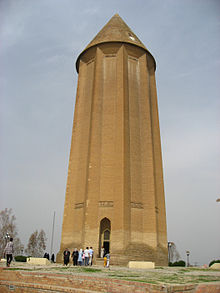Gonbad-e Qaboos
The Gonbad-e Qaboos ( Persian گنبد قابوس) The 1006/07 built is Mausoleum of ziyarid dynasty -Herrschers Qabus (r. 978-981 and 987-1012) in the northern Iranian province of Golestan (formerly Gorgan). Are named after the imposing monument, the small town where the monument stands, and the mainly Turkmen populated county ( Shah residue at ) Gonbad-e Qabus , whose center is the city. Frequent romanization variants are Gonbad-e Kabus , Gonbad-e Kavus , Gunbad-e-Qabus or Gunbad-i-Qabus . The name of the indigenous Turkmen is "Kümmet Gowuz".
builder
Shams al-Maali Abu l-Hasan Qabus ibn Wuschmgir, whose court attracted such great scholars as al-Biruni and Ibn Sina and who was himself a well-known poet, philosopher and astrologer, ruled over parts of Gorgans and at the beginning of the 11th century Tabaristans . As an Orthodox Sunni, he ruled his principality with a very hard hand, which is why he was temporarily banished and even murdered on his return.
architecture

The Gonbad (“dome”, meaning “burial tower”) standing on a small artificial hill - a 52 m high, slightly tapering, cylindrical tower with a conical end - is made entirely of fired bricks. Its walls are three meters thick at the base and have ten supporting buttresses on the outside. Exuding an almost modern aesthetic, the monument is characterized by a strong emphasis on the pure form and a great restraint in the decoration. Only above the entrance (at a height of about eight meters) and directly below the gray-green dome can be found two ten-part ribbons with the following inscription in the Kufi duct:
بسمله - هذا القصر العالى - للامير شمس المعالى - الامير بن الامير - الامير قابوس بن وشمكير - امر ببنائه فى حياته - سنة سبع وتسعين - وثلثمائة قمرية - وسنة خمس وسبعين - وثلثمائة شمسية
In the name of God , this lofty castle belongs to the Emir Shams al-Maali, the Emir and son of an Emir, the Emir Qabus ibn Vuschmgir. He ordered its construction during his lifetime, in the lunar year 397, in the solar year 375.
Since the hijri years mentioned correspond to the Christian periods September 27, 1006 to September 16, 1007 and March 15, 1006 to March 14, 1007 , the tomb must be erected between the end of September 1006 and mid-March 1007 (i.e. during Qaboos' second reign) have been.
A single opening with a pointed arch on the east side of the tower allows entry into the unadorned, continuously hollow interior of the building with a diameter of almost 10 meters. Qabus' glass coffin, which has now disappeared, is said to have been attached to the dome with chains so that it floated 45 m above the ground. On the eastern side of the tent-like roof there is a small opening through which the rays of the morning sun could fall on the coffin located here. This indicates the continued existence of Zoroastrian ideas, because in the funeral rites of the ancient Iranian religion it was important that the corpse had no contact with the ground and on the fourth day after death was exposed to the rays of the sun, on which the soul then went to heaven could strive for.
meaning
The ban on building mausoleums that existed in early Islamic times was first broken at the beginning of the 9th century. At the beginning of the preserved Islamic mausoleums is the domed structure of the Samanids in Bukhara , which is dated before 943. The square structure, which ends with a round dome, became the model for countless mausoleums, especially as Qubba in Arab countries. In the Persian region, the completely different type of tomb towers (Gonbad) took its place in the 11th century. The Gonbad-e Qabus became a model for this. It is the symbol of the region and the tallest and best-preserved of a large number of tomb towers in northern Iran. Like other, similarly designed grave towers, it can also be viewed as a "permanent descendant of the nomadic grave tent". In 2012 the monument was added to the UNESCO World Heritage List .
literature
- André Godard : Gunbad-i-Qabus. In: Arthur Upham Pope, Phyllis Ackerman (Eds.): A Survey of Persian Art from Prehistoric Times to the Present . Oxford University Press, London / New York 1939–1958.
- André Godard: L'Art de l'Iran , Paris 1962
- Ernst Diez : Churasan architectural monuments . Berlin 1918
- Sheila S. Blair: The Monumental Inscriptions from Early Islamic Iran and Transoxiana . Leiden 1992
- Edward Granville Brown: A literary history of Persia . London / Cambridge 1920
Web links
Individual evidence
- ^ E. Ehlers, M. Momeni, Habib-Allāh Zanjāni, Sheila S. Blair: Gonbad-e Qābus. In: Encyclopædia Iranica , 2010
- ↑ Like fire, the earth is considered sacred by the Zoroastrians and should therefore not be contaminated with a corpse.
- ↑ James R. Russell: Burial iii. In Zoroastrianism. In: Encyclopædia Iranica
- ^ Robert Hillenbrand: The Islamic Architecture of Persia. In: Ders .: Studies in Medieval Islamic Architecture. Vol II. The Pindar Press, London 2006, p. 6
- ↑ Alfred Renz: History and Places of Islam . Prestel, Munich 2001, p. 328
- ↑ UNESCO World Heritage Center: Gonbad-e Qābus
Coordinates: 37 ° 15 ′ 29 ″ N , 55 ° 10 ′ 9 ″ E


